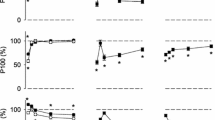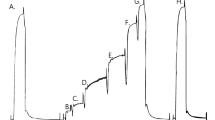Summary
The fine structure of muscle fibres from m. vastus lateralis of nine healthy males (mean age 26 years) was investigated. Four individuals constituted non-exercised controls while five subjects participated in a two-months eccentric muscular training program. Specimens from the controls showed a well-preserved, regular myofibrillar band pattern while changes in the myofibrillar architecture were constantly found in specimens taken after the training program. These changes consisted of Z-band alterations, Z-bands being out of register, extra sarcomeres, Z-band extensions and bisected Z-bands. Between the separated Z-band halves, thin and thick myofilaments as well as abundant glycogen particles and/or ribosomes, were observed. Type-2 (fast-twitch) fibres were predominantly affected. Contrary to the controls the trained individuals constantly showed a greater variation in sarcomere lengths in Type-2 fibres than in Type-1 fibres.
It is concluded that muscular work of high tension can induce fine-structural alterations. When repeated over a long period of time, extreme tension demands seem to initiate reorganization in the muscle fibres, predominantly in the, ultrastructurally defined, Type-2 fibres. This adaptation probably results in a better stretchability of the muscle fibres, reduces the risk for mechanical damage and brings about an optimal overlap between actin and myosin filaments.
Similar content being viewed by others
References
Abbott BC, Bigland B, Ritchie JM (1952) The physiological cost of negative work. J Physiol 117:380–390
Armstrong RB, Ogilvie RW, Schwane JA (1983) Eccentric exerciseinduced injury to rat skeletal muscle. J Appl Physiol 54:80–93
Ashmore CR, Summers PJ (1981) Stretch-induced growth in chicken wing muscles: myofibrillar proliferation. Am J Physiol 51:C93-C97
Barnett JG, Holly RG, Ashmore CR (1980) Stretch-induced growth in chicken wing muscles: biochemical and morphological characterization. Am J Physiol 239:C39-C46
Bigland B, Lippold OCJ (1954) The relation between force, velocity and integrated electrical activity in human muscles. J Physiol 123:214–224
Bishop SP, Cole CR (1969) Ultrastructural changes in the canine myocardium with right ventricular hypertrophy and congestive heart failure. Lab Invest 20:219–229
Bonde-Petersen F (1969) A bicycle ergometer for investigating the effect of eccentric exercise with arms and legs. Int Z angew Physiol 27:133–137
Fridén J, Sjöström M, Ekblom B (1981) A morphological study of delayed muscle soreness. Experientia 37:506–507
Fridén J, Sjöström M, Ekblom B (1983a) Myofibrillar damage following intense eccentric exercise in man. Int J Sports Med 4:170–176
Fridén J, Seger J, Sjöström M, Ekblom B (1983b) Adaptive response in human skeletal muscle subjected to prolonged eccentric training. Int J Sports Med 4:177–183
Fridén J, Kjörell U, Thornell L-E (1983c) Delayed muscle soreness and cytoskeletal alterations. An immunocytological study in man. Int J Sports Med (in press)
Goldberg AL, Etlinger JD, Goldspink DF, Jablecki C (1975) Mechanism of work-induced hypertrophy of skeletal muscle. Med Sci Sports 7:248–261
Goldspink G, Tabary C, Tabary JC, Tardieu C, Tardieu, G (1974) The effect of denervatin on the adaptation of sarcomere number and muscle extensibility to the functional length of the muscle. J Physiol 236:733–742
Gutmann E, Schiaffino S, Hanzlikova V (1971) Mechanism of compensatory hypertrophy in skeletal muscle of the rat. Exp Neurol 31:451–464
Hattori A, Takahashi K (1982) Calcium-induced weakening of skeletal muscle Z-discs. J Biochem 92:381–390
Hayat A, Tardieu C, Tabary JC, Tabary C (1978) Effects of denervation on the reduction of sarcomere number in cat soleus muscle immobilized in shortened position during seven days. J Physiol 74:563–567
Hofmann W (1980) Mechanisms of muscular hypertrophy. J Neurol Sci 45:205–216
Holly RG, Barnett JG, Ashmore CR, Taylor RG, Molé PA (1980) Stretch-induced growth in chicken wing muscles: a new model of stretch hypertrophy. Am J Physiol C62–C71
Jakubiec-Puka A, Kordowska J, Chomontowska H (1982) Z-line changes in the rat muscle maintained in lengthened position. 11th European Congress on Muscle and Motility, Leicester, 14–17 Sept. Abstract p 5–5
Kelly DE (1968) Myofibrillogenesis and Z-band differentiation. Anat Rec 163:403–426
Komi PV (1973) Relationship between muscle tension, EMG and velocity of contraction under concentric and eccentric work. In: Desmedt JE (ed) New developments in electromyography and clinical neurophysiology. Karger, Basel, vol 1, pp 596–606
Lazarides E (1980) Intermediate filaments as mechanical integrators of cellular space. Nature 283:249–256
Legato M (1970) Sarcomerogenesis in human myocardium. J Mol Cell Cardiol 1:425–437
Newham DJ, McPhail G, Mills KR, Edwards RHT (1983) Ultrastructural changes after concentric and eccentric contractions of human muscle. J Neurol Sci 61:109–122
Peachey LD, Eisenberg BR (1978) Helicoids in the T system and striations of frog skeletal muscle fibers seen by high voltage electron microscopy. Biophys J: 145–154
Price HM, Gordon GB, Pearson CM, Munsat TL, Blumberg JM (1965) New evidence for excessive accumulation of Z-band material in nemaline myopathy. Proc Nat Acad Sci USA 54:1398–1406
Rowe RWD, Morton DJ, Weidemann JF (1971) Irregular Z bands occurring in rat soleus muscles. J Ultrastruct Res 36:205–210
Saetersdal TS, Myklebust R, Skagseth E, Engedal H (1976) Ultrastructural studies on the growth of filaments and sarcomeres in mechanically overloaded human hearts. Virchows Arch [Cell Path] 21:91–112
Schiaffino S, Hanzlikova V (1970) On the mechanism of compensatory hypertrophy in skeletal muscles. Experientia 26:152–153
Schmalbruch HZ (1968) Noniusperioden und Längenwachstum der quergestreiften Muskelfaser. Z mikrosk-anat Forsch 79:493–507
Sjöström M, Kidman S, Henriksson Larsén K, Ängquist KA (1982a) Z- and M-band appearance in different histochemically defined types of human skeletal muscle fibers. J Histochem Cytochem 30:1–11
Sjöström M, Ängquist KA, Bylund AC, Fridén J, Gustavsson L, Scherstén T (1982b) Morphometric analyses of human skeletal muscle fiber types. Muscle Nerve 5:538–553
Spector SA, Simard CP, Fournier M, Sternlicht E, Edgerton VR (1982) Architectural alterations of rat hind-limb skeletal muscles immobilized at different lengths. Exp Neurol 76:94–110
Tabary JC, Tabary C, Tardieu C, Tardieu G, Goldspink G (1972) Physiological and structural changes in the cat's soleus muscle due to immobilization at different lengths by plaster casts. J Physiol 224:231–244
Tardieu C, Tabary JC, Tabary C, Huet de la Tour E (1977) Comparison of the sarcomere number adaptation in young and adult animals. J Physiol 73:1045–1055
Thornell LE (1973) Ultrastructural variations of Z bands in cow Purkinje fibres. J Mol Cell Cardiol 5:409–417
Vandenburgh H, Kaufman S (1979) In vitro model for stretchinduced hypertrophy of skeletal muscle. Science 203:265–268
Weibel ER, Bolender RP (1973) Stereological techniques for electron microscopic morphometry. In: Hayat (ed) Principal and techniques of electron microscopy, Van Nostrand Reinhold Company, New York, vol 3, p 237
Williams PE, Goldspink G (1971) Longitudinal growth of striated muscle fibres. J Cell Sci 9:751–767
Williams PE, Goldspink G (1973) The effect of immobilization on the longitudinal growth of striated muscle fibres. J Anat 116:45–55
Williams PE, Goldspink G (1978) Changes in sarcomere length and physiological properties in immobilized muscle. J Anat 127:459–468
Author information
Authors and Affiliations
Rights and permissions
About this article
Cite this article
Fridén, J. Changes in human skeletal muscle induced by long-term eccentric exercise. Cell Tissue Res. 236, 365–372 (1984). https://doi.org/10.1007/BF00214240
Accepted:
Issue Date:
DOI: https://doi.org/10.1007/BF00214240




